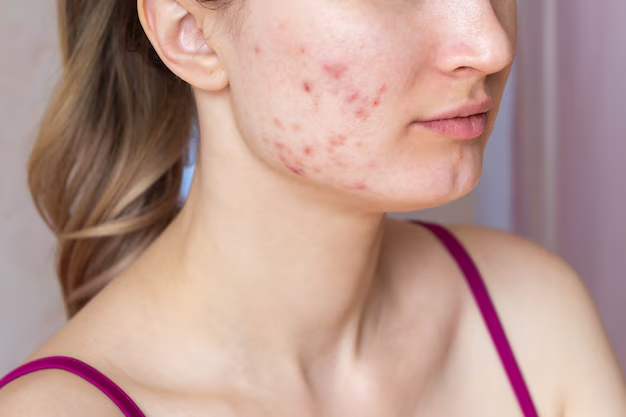Understanding Fungal Acne: What Causes It and How It Impacts Your Skin
If you've ever struggled with persistent acne that just doesn't seem to respond to typical treatments, you might be dealing with something more than just your average skin breakout. Many people are unaware of fungal acne, a condition that mimics traditional acne but requires a different approach to treatment. But what exactly causes fungal acne, and how does it affect your skin?
What is Fungal Acne?
Fungal acne, also known as Malassezia folliculitis or pityrosporum folliculitis, is not actually acne in the traditional sense. Unlike bacterial acne, which is caused by clogged pores due to excess oil, dead skin cells, and bacteria, fungal acne is a result of an overgrowth of yeast within the hair follicles.
Key Differences Between Fungal and Bacterial Acne
- Cause: Fungal acne is caused by yeast, while bacterial acne is caused by bacteria.
- Appearance: Fungal acne often appears as itchy, uniform red bumps, whereas bacterial acne can present as various-sized pimples, blackheads, or cysts.
- Location: Fungal acne commonly occurs on the chest, back, and shoulders, though it can also appear on the face.
Understanding these differences is crucial for effective treatment, as misdiagnosis can lead to prolonged discomfort and ineffective skincare routines.
What Causes Fungal Acne?
Fungal acne emerges when there’s an imbalance in the skin's microbiome—specifically, when yeast outnumbers other microorganisms. Here are some key factors that contribute to this imbalance:
1. Heat and Humidity
Hot and humid environments create the perfect breeding ground for yeast to thrive. When it's hot, you sweat more, and yeast feeds on the fatty acids in sweat, leading to overgrowth.
2. Excessive Sweating
Activities that cause you to sweat profusely, like exercising or wearing non-breathable fabrics, can exacerbate fungal acne. Always showering and changing clothes promptly after a sweat session can help mitigate this issue.
3. Use of Heavy Skincare Products
Thick creams and oils can clog pores, trapping sweat and encouraging the growth of yeast. Opting for lightweight, non-comedogenic products can aid in preventing this condition.
4. Antibiotic Use
Antibiotics can disrupt the natural balance of bacteria in your skin, reducing their population and giving yeast the opportunity to multiply uncontrollably.
5. Weakened Immune System
Individuals with weakened immune systems are more susceptible to fungal acne as their bodies struggle to keep yeast levels in check.
How to Identify Fungal Acne
Identifying fungal acne is crucial as it dictates the kind of treatment you require. Here are some characteristics to look out for:
- Uniform Bumps: Unlike bacterial acne, the bumps are usually of the same size and appear in clusters.
- Itchiness: Fungal acne tends to be itchy, whereas bacterial acne may not cause itching.
- Persistent Nature: If traditional acne treatments aren’t working, this could signal fungal acne.
If you're unsure, it might be helpful to consult a dermatologist who can observe these signs more accurately.
Preventive Measures for Fungal Acne
Preventing fungal acne revolves around maintaining the skin's natural balance and ensuring yeast doesn't have the opportunity to overgrow. Here are some practical steps:
Keep Skin Dry and Clean
- Regular Showers: Wash off sweat immediately after activities.
- Breathable Fabrics: Wear clothes made from natural fibers like cotton.
Use Skincare Wisely
- Opt for Lightweight Products: Choose skincare products labeled non-comedogenic and oil-free.
- Avoid Overuse of Antibiotics: Use antibiotics only when absolutely necessary and under professional guidance.
Environmental Adjustments
- Manage Humidity: Use a dehumidifier in damp climates to reduce moisture that encourages yeast growth.
Treatment Options for Fungal Acne
While we've covered prevention, if you're already dealing with fungal acne, it’s essential to explore effective treatment options. Remember, what works for bacterial acne might not work here!
Topical Treatments
- Anti-Dandruff Shampoos: Ingredients like ketoconazole or selenium sulfide can be used as a topical wash on affected areas.
- Antifungal Creams: Look for over-the-counter options containing clotrimazole or miconazole.
Oral Medications
In more severe cases, a doctor might prescribe oral antifungal medications to systematically reduce yeast populations.
Lifestyle Changes
- Diet: Reducing sugar and carb intake can also help manage yeast levels, as these foods can feed yeast.
Empowering Knowledge About Your Skin
Understanding the root cause of your skin issues can empower you to make informed decisions about your skincare routine. Rather than feeling overwhelmed by yet another skin condition, knowing that fungal acne is manageable is a first step towards healthier skin.
By seeking knowledge about the causes and appropriate treatments, you take control over your skin’s wellness. Always remember, skin health doesn’t just contribute to the aesthetic but also to overall well-being.
Quick Summary: Fungal Acne Overview
- Definition: Fungal acne is a misnomer; it is actually yeast overgrowth in hair follicles.
- Causes: Includes humid environments, excessive sweating, and the misuse of antibiotics.
- Identifying Features: Uniform, itchy red bumps, often resistant to traditional acne treatment.
- Prevention: Maintain dry skin, use lightweight products, and manage environmental factors.
- Treatment: Involves antifungal topical treatments, possibly oral medication, and lifestyle adjustments.
- Empowerment: Understanding this condition allows for proactive management and reduced flair-ups.
🌡️ Environment: Control heat and humidity. 🧴 Skincare: Use products wisely—opt for non-comedogenic formulations. 🧼 Hygiene: Quick showers post-sweat, and wear breathable materials.
